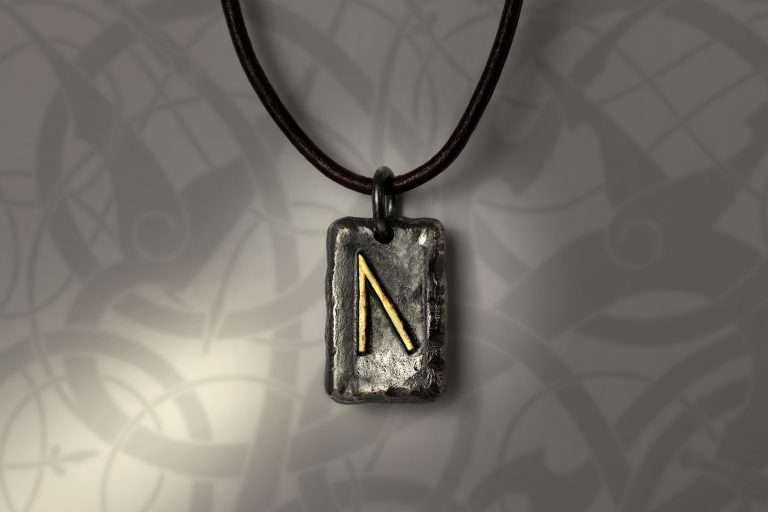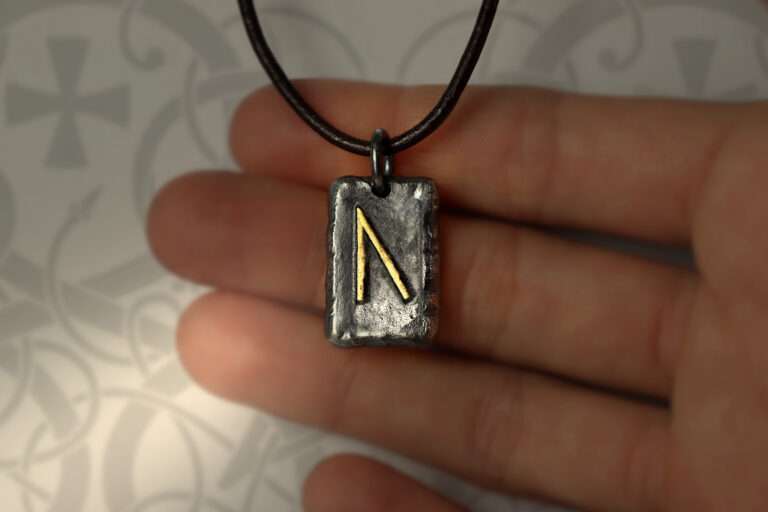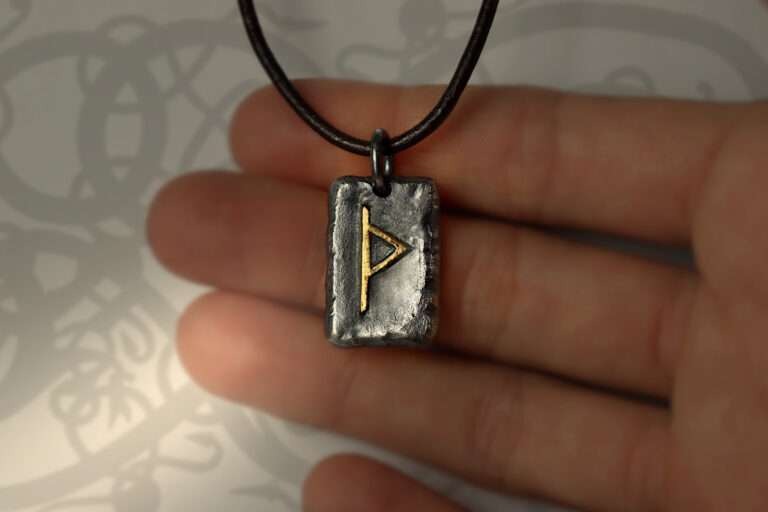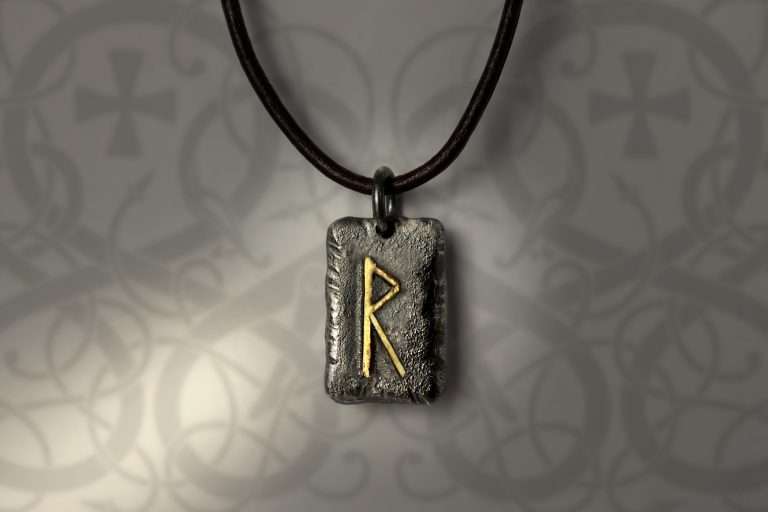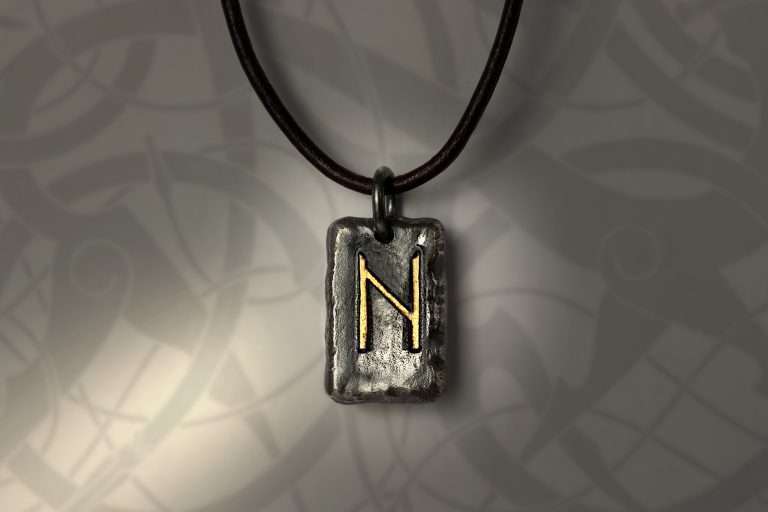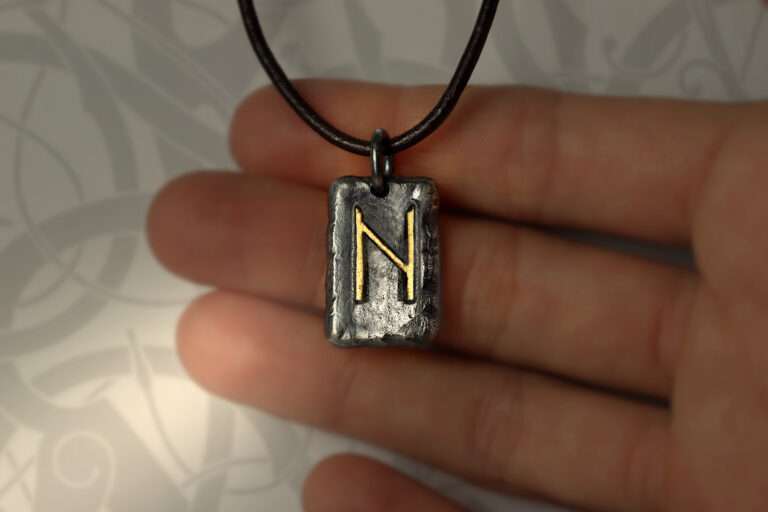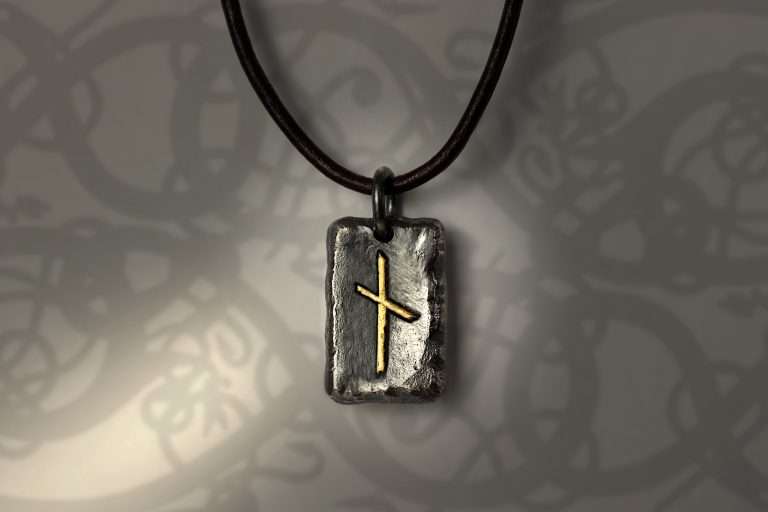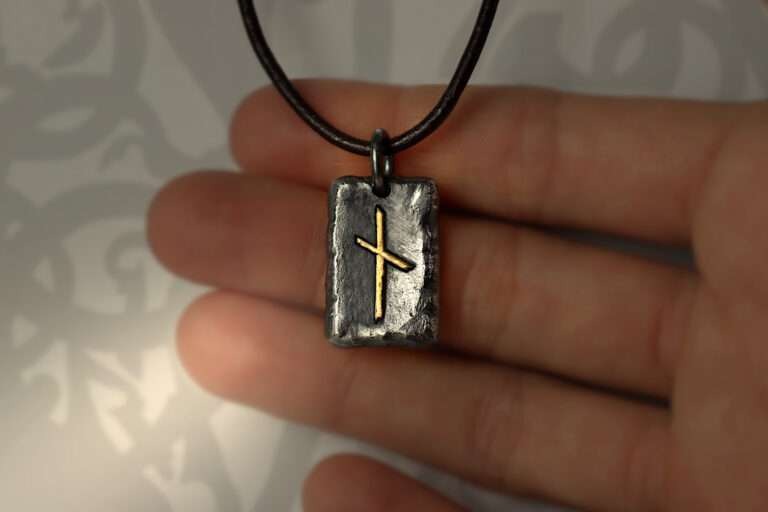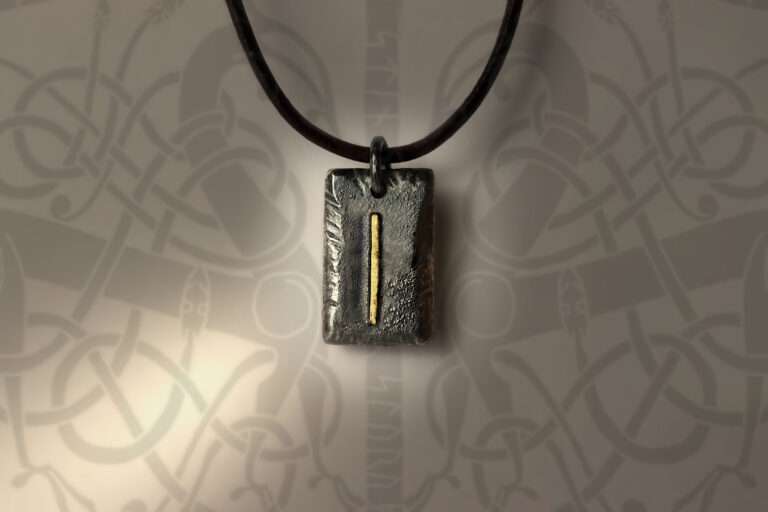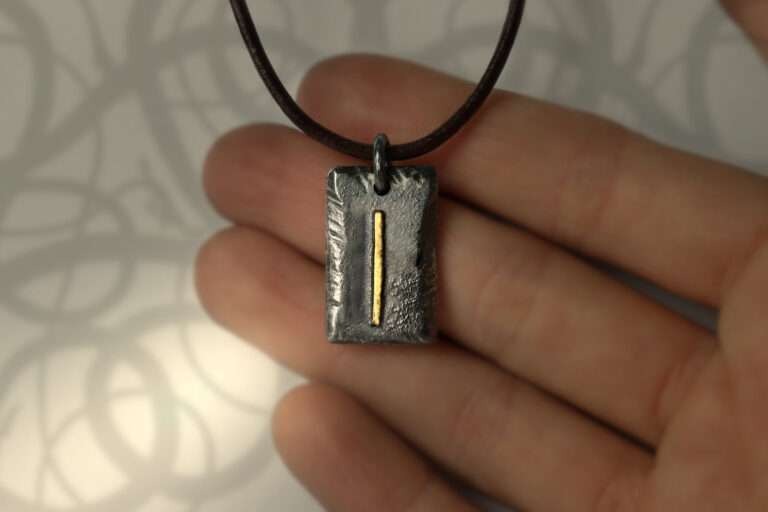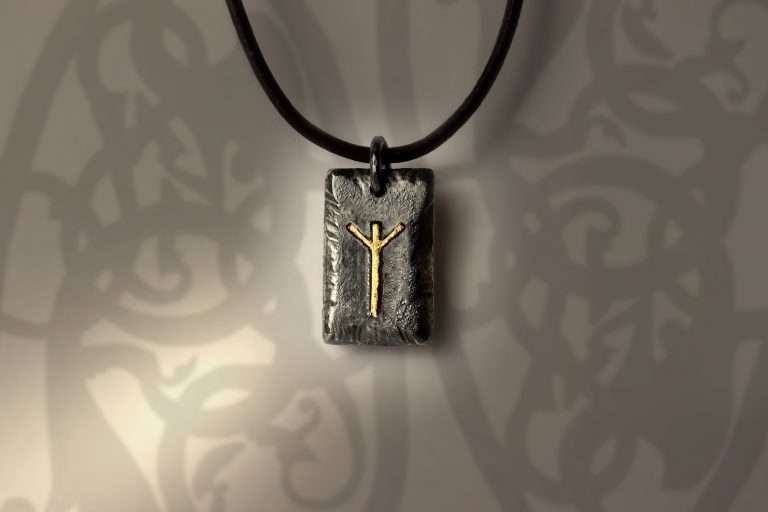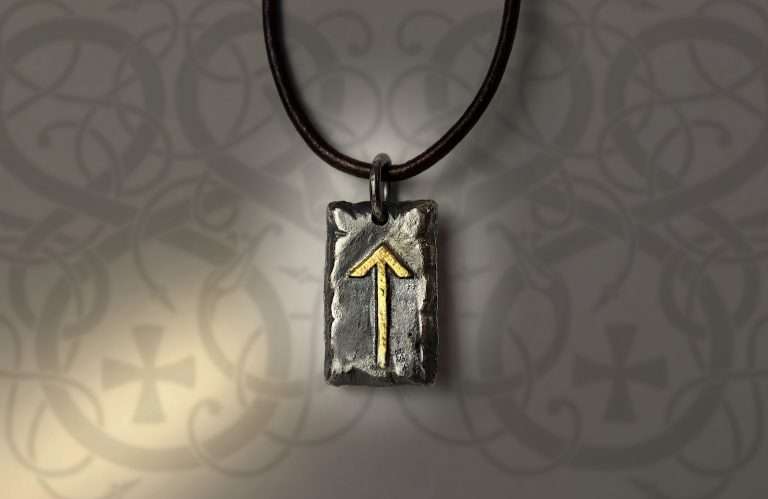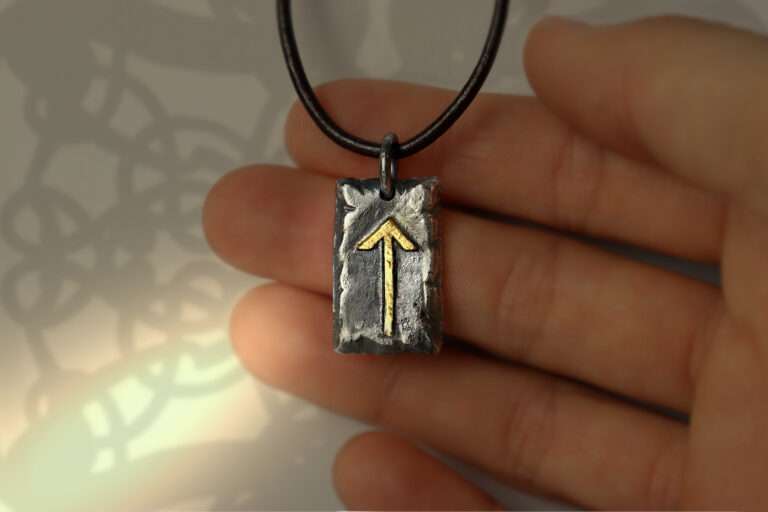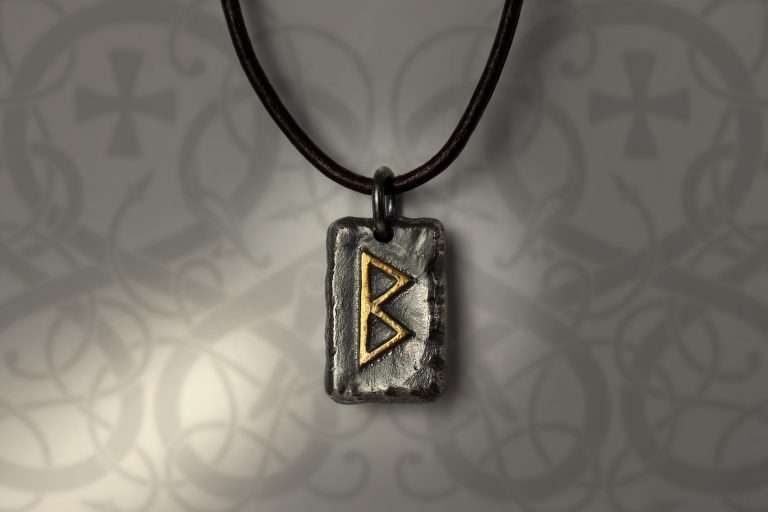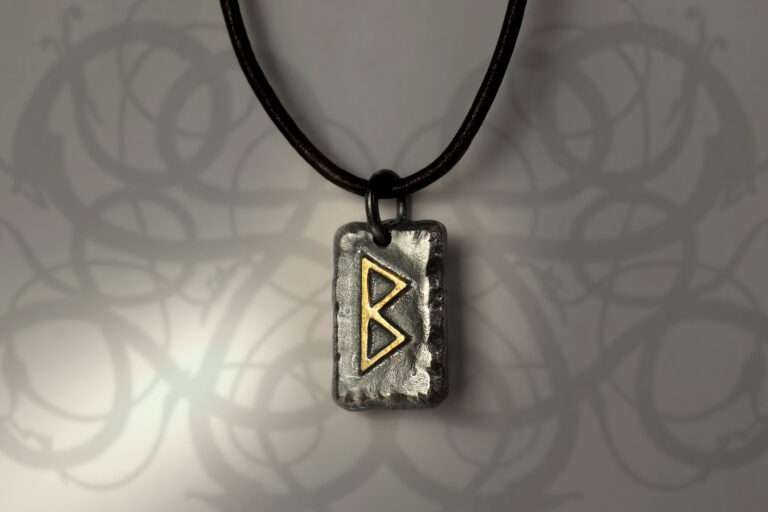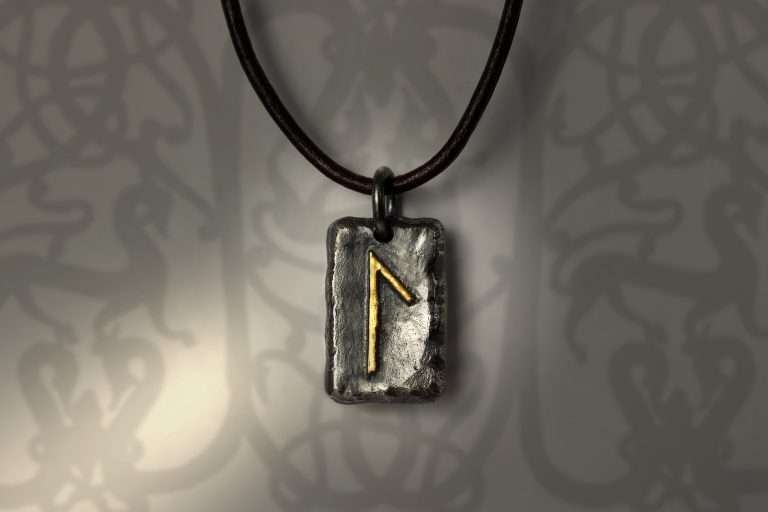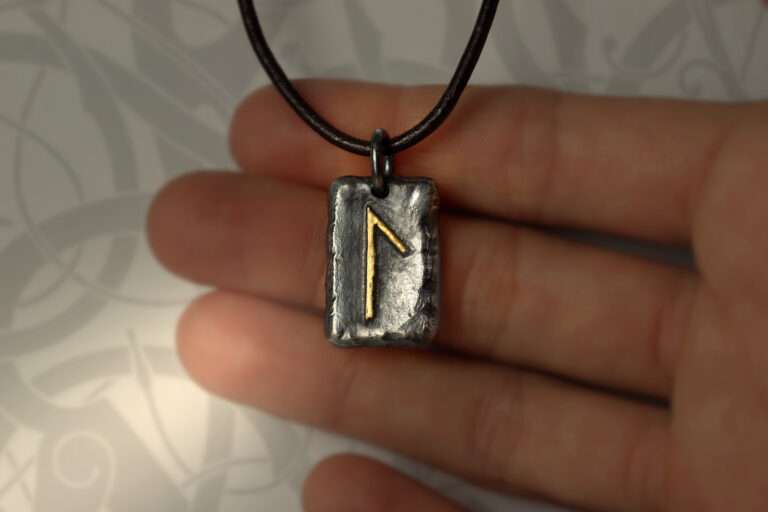Elder Futhark
This is our comprehensive guide on the mystical world of the Elder Futhark – the oldest form of the runic alphabets used by older Norse tribes for writing, divination, and magic from the 2nd to 8th centuries, after which the vikings evolved the alphabet into the Younger Futhark. The runes were more than just a collection of symbols like we see our alphabet today. Instead each rune embodies complex meanings, cultural significance, and historical insights.
To read more about why runes have extra symbolic meaning attached to them head over to our blog post on kennings and their use in old Norse poetry.
This is our attempt at unraveling the secrets of the Elder Futhark, offering analysis, historical and literary context, and interpretations to help you understand the symbolism and significance each rune holds.
Click the associated rune in the gallery below to jump straight to that rune’s description.
Fehu

Fehu in proto-Germanic or fé in old Norse from the younger futhark, is the rune letter F or sometimes V, means cattle or wealth. In old Norse times livestock was directly related to wealth and security, as it ensured one would not starve even if harvest failed.
Ef maðr grefr fe sit i iorð til hirzlo gull eþa silfr oc varðar þat fiorbavgs garð.
If a man digs his goods in the ground to hide gold and silver, he shall be punished with banishment.
Fehu symbolizes material and spiritual prosperity, as well as the importance of sustenance and resources for survival. It signifies wealth not only in terms of tangible assets but also in terms of inner richness, including health, relationships, and personal growth.
Fehu inspires a recognition of our innate ability to attract abundance and to manifest desires through focused intention and hard work. It emphasizes the cyclical nature of wealth, highlighting the importance of sharing and circulating resources to maintain balance and harmony. Fehu encourages gratitude for the blessings already present in our lives while motivating continuous effort towards achieving greater prosperity and fulfillment in all aspects of existence.
-

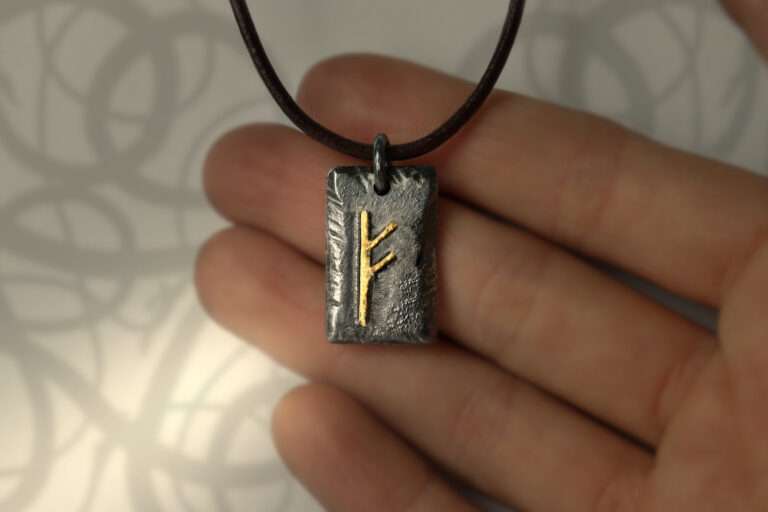
Fehu Golden Glyph Rune Pendant Necklace
Fe Rated 0 out of 5 NOK 2010 Add to cartQuick View
Uruz

Uruz is the rune letter U. In old Norse ur from the younger futhark means dross (iron slag) or rain, while in proto-Germanic it is known as uruz interpreted as "aurochs" (an ancient type of wild ox) or water. Aurochs was known as a formidable, wild beast. In modern Scandinavian languages ur means first or original and is used as a prefix - aurochs in Norwegian is urokse - "ancient ox". In this respect uruz is a representation of our primal past.
Ginnungagap, þat er vissi til norðrættar, fylltist með þunga ok höfugleik íss ok hríms ok inn í frá úr ok gustr, en inn syðri hlutr Ginnungagaps léttist mót gneistum ok síum þeim, er flugu ór Múspellsheimi.
Ginnungagap, the part that faces the north filled with heavy and hard ice and frost and within there was rain and storm, while the southern part of Ginnungagap was lit up from flying sparks from Muspellheim.
Uruz symbolizes raw energy and the courage to confront challenges head-on. It signifies physical and mental strength, resilience, and the ability to overcome obstacles through sheer determination and perseverance.
Wearing the talisman will encourage harnessing our inner strength and tap into our primal instincts to navigate life's trials. It prompts introspection, invites confronting one's fears, embracing change, and unleashing our full potential. Uruz teaches us the importance of resilience and adaptability, reminding us that challenges are opportunities for growth and self-discovery. By embodying the energy of Uruz, we can tap into our innate power, cultivate inner fortitude, and confidently stride forward on our journey towards self-empowerment and personal evolution.
-


Uruz Golden Glyph Rune Pendant Necklace
Golden Glyph Pendants Rated 0 out of 5 NOK 2010 Add to cartQuick View
Thurisaz

Thurisaz, the rune letter equivalent of TH, sometimes also written þurisaz, comes from proto-Germanic and is equal to thurs, or þurs, in old Norse younger futhark, is a kind of jotunn - a giant or ogre from Norse mythology.
Þrymr sat á haugi, þursa dróttinn,
greyjum sínum gullbönd sneri
ok mörum sínum mön jafnaði.Trym sat on the hill, the lord of the thurs,
twisted golden bands for his dogs,
and smoothed his horses' manes.
Giants or thurses in Norse mythology symbolised challenges, resistance, and the raw forces of nature. These beings represented immense power and the untamed aspects of the world, embodying natural phenomena that were both revered and feared. Thurisaz reflects the struggle against difficulties and the need for protection against the chaotic elements of life. It teaches the value of resilience and the strength found in facing adversities head-on.
For us, wearing the thurisaz rune can be a powerful symbol of our own battles with external and internal giants. It encourages us to confront our fears, to stand firm in the face of life's storms, and to seek strength within ourselves and our spiritual beliefs. Thurisaz inspires us to find balance amidst chaos, offering protection as we navigate through life's challenges. By connecting with the essence of thurisaz, we enhance our spiritual life, acknowledging the trials we face and the growth that comes from overcoming them, fortified by the ancient wisdom of resilience and perseverance.
-


Thurisaz Golden Glyph Rune Pendant Necklace
Golden Glyph Pendants Rated 0 out of 5 NOK 2010 Add to cartQuick View
Ansuz

Ansuz in proto-Germanic, representing the rune letter A, or óss or as in old Norse's younger futhark and means "God" or specifically it refers to the Æsir - the main family group of gods in Norse mythology. In the old Icelandic rune poem óss refers to Odin directly.
Óðinn er æðstr ok elztr ásanna. Hann ræðr öllum hlutum, ok svá sem önnur goðin eru máttug, þá þjóna honum öll svá sem börn föður [...]
Odin is the highest and oldest of the Æsir. He rules over all things, and no matter their power, all the other gods obey him like they were his children [...]
Odin was not only the god of war, but also that of wisdom and poetry. He importantly sacrificed one of his eyes to drink from Mimir's well, making him all-knowing. Odin has two ravens, Hugin and Munin, returning to him each day to relay him information of everything that happens. The summoning of Odin is an invocation of divine inspiration, the pursuit of truth and knowledge, and the ability to shape one's destiny through language and understanding.
Ansuz embodies the concept of communication, divine inspiration, and the transmission of wisdom from the gods. It signifies the power of speech, language, and the spoken word as vehicles for expressing truth, wisdom, and divine guidance. It encourages clear communication and effective expression, urging individuals to listen attentively to the messages of the gods and to communicate with integrity and authenticity.
Ansuz encourages us to recognize the importance of divine inspiration and spiritual insight in guiding our actions and decisions. It serves as a reminder that our words are the architects of our fates, and our silence the sanctuary of our thoughts. By attuning to the wisdom of the divine and speaking with honesty and clarity, individuals can align themselves with higher truths and cultivate deeper connections with the divine forces that shape our lives.
-


Ansuz Golden Glyph Rune Pendant Necklace
Ansuz Rated 0 out of 5 NOK 2010 Add to cartQuick View
Raidō

Raido, the rune letter R, often also written raidō, from proto-Germanic, or reið in old Norse younger futhark means "ride" or "journey".
Högni hét konungr. Hans dóttir var Sigrún. Hon var valkyrja ok reið loft ok lög. Hon var Sváfa endrborin. Sigrún reið at skipum Helga [...]
A king was named Högne. His daughter was Sigrún. She was a valkyrie and rode through air and sea. She was Svava reborn. Sigrún rode to Helge's ship [...]
Raido symbolizes both physical journeys and inner quests for personal growth and enlightenment. It prompts individuals to embrace change, embark on new adventures, and navigate through life's transitions with courage and resilience. Raido also symbolizes the importance of balance and harmony in one's journey, urging individuals to stay grounded while pursuing their aspirations.
Raido encourages recognizing the interconnectedness of all journeys and the lessons to be learned along the way. By embracing the energy of raido, one can align themselves with the flow of life, embrace new experiences, and embark on a transformative journey towards self-discovery and personal evolution. The essence of Raido emphasizes the journey's importance over the destination.
-


Raido Golden Glyph Rune Pendant Necklace
Golden Glyph Pendants Rated 0 out of 5 NOK 2010 Add to cartQuick View
Kaunan

Kaunan, the rune letter K, or kauna both from proto-Germanic, the same as kaun in old Norse younger futhark, is most often translated as "ulcer". However in actual use, kaunan has been used to mean wound or scab. In this interpretation kaunan can be a used as a reminder of our wounds and act as a healing talisman for them.
Kaun er bæygja barna,
bǫl gørvir mann fǫlvan.Kaun is children's curse,
the misfortune makes one pale.
Kaunan symbolizes both physical injuries and emotional scars, highlighting the process of transformation and regeneration that follows adversity.
Kaunan represents the journey of healing and self-restoration. It encourages confronting inner wounds, acknowledging past traumas, and embracing the healing process with courage and resilience. Kaunan also symbolizes the importance of self-care and nurturing, urging us to prioritize emotional well-being and cultivate our inner strength.
It involves recognizing the transformative power of healing and the potential for growth that arises from overcoming adversity. By embracing the energy of Kaunan, we can embark on a journey of self-discovery, find closure from past wounds, and emerge stronger and more resilient on the path towards personal wholeness and inner peace.
-


Kaunan Golden Glyph Rune Pendant Necklace
Golden Glyph Pendants Rated 0 out of 5 NOK 2010 Add to cartQuick View
Gebō

Gebō, the rune letter G, means gift or generosity in proto-Germanic. Gebō has no equal in the younger futhark, but the comparative term in old Norse would be gjǫf. In old Norse there is also a related word, gáfa, specifically meaning a spiritual gift.
It invokes the idea of human connection and partnership, and the importance of transferring knowledge and imparting spiritual gifts to others.
Undr mikit, er þvílíkr höfðingi sem Freyr er vildi gefa sverð, svá at hann átti eigi annat jafngott. Geysimikit mein var honum þat, þá er hann barðist við þann, er Beli heitir. Þat veit trúa mín, at þeirar gjafar myndi hann þá iðrast.
It amazes me that a Chieftain like Frøy would give away his sword, when he had no other equally good one. It was a great disadvantage for him, when he fought Bele. Then he must have regretted his gift.
Gebo signifies the importance of reciprocity, balance, and mutual respect in relationships. It prompts cultivating harmonious connections with others based on trust, generosity, and shared values. Gebo also symbolizes the exchange of energy and the interconnectedness of all beings, urging both giving and receiving with an open heart and to honor the flow of abundance in your life.
Gebo encourages recognizing the significance of mutual exchange and partnership in fostering growth and prosperity. By embodying the energy of Gebo, we can cultivate meaningful relationships, embrace the spirit of generosity, and experience the joy of giving and receiving in equal measure, thereby fostering greater harmony and balance in your life.
-


Gebo Golden Glyph Rune Pendant Necklace
Gebo Rated 0 out of 5 NOK 2010 Add to cartQuick View
Wunjō

Wunjō, the rune letter W, in proto-Germanic means joy or happiness. The rune does not exist in the younger futhark, but the comparative term in old Norse would be yndi or ynði.
Þær at lúðri leiddar váru
ok grjóts gréa gangs of beiddu;
hét hann hvárigri hvíld né ynði,
áðr hann heyrði hljóm ambátta.They were both led to the mill
and the grey grindstone they teased into motion;
he offered neither rest nor happiness,
before he heard their sound.
Wunjo signifies the pursuit of happiness and contentment in life. It encourages seeking joy and fulfillment in your experiences, relationships, and endeavors. Wunjo symbolizes the ultimate goal of human existence—to find inner peace and satisfaction amidst life's challenges.
Wunjō cultivates a positive mindset and embracing life with gratitude and optimism. By embodying the energy of Wunjō, we can cultivate a sense of inner peace, happiness, and contentment, regardless of external circumstances. Wunjō encourages individuals to appreciate the blessings in their lives, celebrate their successes, and find joy in the simple pleasures of everyday existence, thereby enhancing their overall well-being and sense of fulfillment.
-


Wunjo Golden Glyph Rune Pendant Necklace
Golden Glyph Pendants Rated 0 out of 5 NOK 2010 Add to cartQuick View
Hagalaz

Hagalaz is the rune letter H. Hagalaz or haglaz in proto-Germanic, or hagall in old Norse younger futhark means hail, as in the weather phenomenon where ice falls from the sky.
[...] ok nú tekr veðrið at ylgjast í norðrit, ok dregr upp ský dökkt ok dimmt með hafino, ok gengr upp með öllo skjótt;
en þat var í þat mund dags, er tók út eyktina,
ok dregr nú yfir skýit skjótt ok fylgir þegar jel, ok þótti þeim, sem þángat væri bæði eldíngar ok reiðar þrumor, því allir Jómsvíkíngar átto at vega í gegn jelino.[...] and now the weather began to change sharply in the north,
and there grew up a black and threatening cloud from the sea, and it rose with great speed;
it was at that time of day, half-past three,
and then it quickly clouded over, followed by hail,
and it seemed to them that it would be both lightning and angry thunder,
because all of Jomsvikings got the weather right against them.
Hail has the possibility to injure and damage, but it will always melt and become water. Hagalaz represents the transformation from something bad to something good, from something destructive to something life-giving. It can both be a representation of an external act, which had damaged us but we are looking to turn into something constructive, or it can symbol an internal shift in ourselves - a transformation of our own destructive thoughts or actions into positive and constructive insight.
Hagalaz signifies the inevitability of upheaval and the need to confront challenges with resilience and adaptability. It prompts individuals to embrace change as a natural part of life and to find strength in times of adversity. Hagalaz symbolizes the cleansing power of storms, purging away obstacles and paving the way for new growth and renewal.
By embracing the energy of Hagalaz one can navigate through tumultuous times with courage and grace, trusting in the process of change and finding opportunities for growth amidst the challenges. Hagalaz reminds us to remain resilient and to have trust in our inner strength, knowing that we have the power to weather any storm and emerge stronger on the other side.
-


Haglaz Golden Glyph Rune Pendant Necklace
Golden Glyph Pendants Rated 0 out of 5 NOK 2010 Add to cartQuick View
Naudiz

The rune letter N, Naudiz in proto-Germanic or nauðr in old Norse younger futhark means need or hardship.
Sátu síðan sjau vetr at þat, en inn átta allan þráðu, en inn níunda nauðr of skilði; meyjar fýstusk á myrkvan við, Alvitr unga, örlög drýgja.
Seven winters they sat together, in the eighth longing returned, in the ninth need separated them; the maidens longed for the dark forest, fate will decide for the young all-wise.
Naudr signifies the experience of lack, scarcity, and adversity in life. It prompts us to confront our needs and limitations with courage and resourcefulness, urging us to seek solutions and overcome obstacles through perseverance and determination. Naudr symbolizes the importance of resilience and self-reliance in times of hardship, encouraging us to tap into our inner strength and find creative ways to address our needs.
Naudr reflects the transformative potential of adversity and the opportunity for growth that arises from facing challenges. By embracing the energy of Naudr, we can navigate through difficult times with resilience and determination, knowing that hardship is often a catalyst for personal development and inner strength. Naudr reminds us to remain steadfast in our pursuit of solutions and to trust in our ability to overcome obstacles, emerging stronger and more resilient on the other side.
-


Naudiz Golden Glyph Rune Pendant Necklace
Golden Glyph Pendants Rated 0 out of 5 NOK 2010 Add to cartQuick View
Isaz
The rune letter I, Isaz in proto-Germanic or íss in old Norse younger futhark means ice. Isaz represents stillness, stagnation, and the frozen state of winter. Isaz is a reflection of ice's dual nature: a serene yet treacherous force. It embodies the profound silence of the frozen expanse, the contemplative pause before action.
At kveldi skal dag leyfa,
konu, er brennd er,
mæki, er reyndr er,
mey, er gefin er,
ís, er yfir kemr,
öl, er drukkit er.At night praise the day,
a wife when she is burned [buried],
a sword when it has been proven [in battle],
a maiden when she is married,
ice when you have crossed,
beer when it has been drunk.
Isaz signifies the need for patience, introspection, and inner reflection. It prompts us to embrace moments of stillness and solitude as opportunities for self-discovery and personal growth. It symbolizes the frozen state of the subconscious mind, urging us to look deep within ourself to uncover hidden truths and insights.
Isaz reflects the importance of embracing periods of stagnation and introspection in life. By embodying the energy of isaz we don the mantle of the philosopher, navigating the silent corridors of thought with the measured pace of the contemplative. It is a reminder that in the heart of stillness lies the seed of action, that in the depth of winter's embrace we are invited to ponder our direction and purpose. We can cultivate inner peace and clarity amidst life's uncertainties, allowing space for inner transformation and personal evolution to unfold.
Isaz reminds us to trust in the natural rhythms of life and to have faith that growth and renewal will emerge from moments of careful stillness and introspection. We are called to honor the silent spaces between our actions, to find within the cold a friend to our deliberations, and to emerge from introspection with the clarity of ice.
-


Iss Golden Glyph Rune Pendant Necklace
Golden Glyph Pendants Rated 0 out of 5 NOK 2010 Add to cartQuick View -


Isaz Golden Glyph Rune Pendant Necklace
Golden Glyph Pendants Rated 0 out of 5 NOK 2010 Add to cartQuick View
Jera

Jera, the rune letter J, means year or harvest in proto-Germanic. The equivalent in old Norse younger futhark is ár.
Þá skyldi blóta í móti vetri til árs,
en at miðjum vetri til gróðrar,
it þriðja at sumri, þat var sigrblótThen they should blóta for a good harvest;
mid winter for a good crop,
and third time in the summer, that was a victory blót.
Jera signifies the culmination of efforts and the manifestation of desires. It prompts us to celebrate the fruits of our labor and to express gratitude for the blessings in our lives. Jera symbolizes the abundance of nature and the importance of sharing and generosity in fostering prosperity and harmony.
Jera unfolds as a symbol woven with the threads of time, a representation of the earth’s generous cycles, yielding the fruits of human toil. It reflects the importance of gratitude and appreciation in cultivating abundance. By embodying the energy of Jera, we can cultivate a mindset of abundance and attract more blessings into our lives. Jera reminds us to acknowledge the abundance that surrounds us and to share our blessings with others, fostering a sense of community and interconnectedness that enriches the lives of all.
-


Jera Golden Glyph Rune Pendant Necklace
Golden Glyph Pendants Rated 0 out of 5 NOK 2010 Add to cartQuick View
Eihwaz

Eihwaz, most often represented as the letter Ï, means yew-tree in proto-Germanic. The comparable term in old Norse younger futhark is ýr. Metaphorically it can also mean a bow.
Setr of vísa vitran
vígdrótt,
en þar hníga,
ýr dregsk,
við skotskúrum,
skjaldborg,
í gras aldir.The seat of the wise ruler,
the kings's warriors,
but the men protect,
bows are drawn,
against a hail of arrows,
shield wall,
in the grass they slump.
The yew is known for its longevity - we know of still standing yew trees that are over a thousand years old, while being extraordinarily poisonous except for the flesh of the berries - serving both as a life giver and a death bringer. The yew also has properties which makes it the optimal wood to make bows from. To the Norse the yew likely held significant meaning. Scholars have gone so far as to suggest that the sacred tree at the Temple of Uppsala in Sweden was a yew.
To the Vikings, the yew would have underscored the cyclical nature of life and death, and represented endurance, transformation, and protection through its ability to transform into essential tools of both sustenance and defense.
Eihwaz can serve as a potent emblem of resilience and perseverance through life's trials. It symbolizes our capacity for personal growth, even through challenges, and reminds us of the continuous cycle of rebirth and renewal. It encourages us to embrace change and can help protect us from negative influences, and support our spiritual journey towards understanding the interconnectedness of life and death, embracing the transformations that define our existence.
-


Eihwaz Golden Glyph Rune Pendant Necklace
Eihwaz Rated 0 out of 5 NOK 2010 Add to cartQuick View
Perþō

Perþō, the rune letter P, is one of the most mysterious of the runes. Little is actually known of it, but it has been suggested it could mean "pear tree" or in a larger context it could refer to fruit-bearing trees in general. The word is proto-Germanic, and its comparative phrase in old Norse would be peru-tré.
Þá mælti Karlamagnús við Vinant ok Macharium,
at þeir skyldu láta höggva perutré þau öll, er þeir fundu,
ok flytja þangat öll í vögnum,
ok allan þann bezta við er vér fám flytit til vár;
ek skal láta reisa eina stóra höll.Then Charlemagne spoke to Vinant and Macharium,
that they should cut down all the pear trees that they found
and all move there in wagons,
and all the best can be moved by spring;
I will have a big hall built.
Assuming this meaning we can draw parallels to themes of prosperity, abundance, and renewal. Perþō might symbolize nourishment and resilience, embodying the cycle of growth and the sustenance of life.
Perþō reminds us of the abundance within and around us. It encourages us to embrace growth, fertility, and the nurturing aspects of our existence. The rune serves as a talisman for attracting prosperity, encouraging personal development, and fostering a deep appreciation for the natural cycle of renewal and abundance.
-


Pertho Golden Glyph Rune Pendant Necklace
Golden Glyph Pendants Rated 0 out of 5 NOK 2010 Add to cartQuick View
Algiz

Algiz, the rune letter Z, means elk or moose in proto-Germanic. The comparable term in old Norse would be elgr.
Þat var maðr upp, en elgr niðr frá nafla. Hann er nefndr Elg-Fróði.
He was a man on top, but elk from the navel down. He was called Elk-Frode.
Algiz symbolises protection, defence, and embodies a strong connection to the animal world. The elk is known in Scandinavia as an aggressive adversary when it feels threatened and especially the female elk is known as a fierce protector of her young. To the vikings then, the elk would have been a symbol of the strength of the forest, the unspoken covenant between beast and man, and the sanctuary found within the heart of the wild.
Algiz can serve as a powerful token for enhancing spiritual protection and growth, foster a sense of safety, ward off negative energy, and help us connect more deeply with our inner wisdom and the protective energies of the universe. It encourages mindfulness of our surroundings and inner self, acting as a reminder of the strength and support available from the natural world.
Algiz is a silent oath to honour the strength borrowed from the earth's ancients, a pact made with the spirit of the elk, promising vigilance and protection. With Algiz we carry the quiet power of the wild within, navigating the world's deceit with the wisdom of the forest, a testament to the enduring bond between the human spirit and the animal world.
-


Algiz Golden Glyph Viking Rune Ring
Algiz Rated 0 out of 5 NOK 3000 Select optionsQuick View -


Algiz Golden Glyph Rune Pendant Necklace
Algiz Rated 0 out of 5 NOK 2010 Add to cartQuick View
Sōwilō

Sōwilō, the rune letter S, in proto-Germanic or sól in old Norse younger futhark means sun.
Sól er landa ljóme;
lúti ek helgum dóme.Sun is the light of the world;
I bow to the holy judgement.
The sun itself was an extremely strong symbol within Norse mythology, embodying light, life, and vitality.
The sun was absolutely central to Norse common life and the source of some of the most significant rituals such as blót, often celebrated in relation the the solstices. For a group of people who were cast into the cold and dark embrace of winter for a large part of the year, the sun would been a fundamental life giver. As such, the sun was central to the Viking cosmology and daily life and the sun's journey across the sky was a powerful reminder of the cycles of nature and the passage of time.
Sól was also a deity that drove the chariot of the sun across the sky, battling the forces of darkness to bring daylight to humanity. This endless cycle of night turning into day symbolizes the eternal struggle between light and dark.
We can interpret this struggle in the context of the human spirit, highlighting themes of hope, renewal, and the perseverance of life. Sōwilō enables us to connect with one of the most prominent ancient energies, enhancing our spiritual life by reminding us of the light that is always present: day will always succeed night, light succeeds darkness. It encourages us to seek out growth, warmth, and enlightenment on our paths, offering protection against negativity and guiding us towards clarity and understanding. Sōwilō helps us remember the importance of cycles in our lives, the constant presence of light and life, and our own inner strength to face challenges with resilience and optimism.
-


Sowilo Golden Glyph Rune Pendant Necklace
Golden Glyph Pendants Rated 0 out of 5 NOK 1990 Add to cart Quick View
Tiwaz / Teiwaz

Tiwaz is the rune letter T. Tiwaz or teiwaz in proto-Germanic, or týr in old Norse younger futhark, is named after the god Tyr.
Sá er enn áss, er Týr heitir.
Hann er djarfastr ok bezt hugaðr, ok hann ræðr mjök sigri í orrostum.
Á hann er gott at heita hreystimönnum.There is another Aas, called Tyr.
He is very bold and brave, and he decides over victory in war.
Warriors should invoke him.
Týr is the Norse god of war and justice, embodies principles of courage, sacrifice, and the lawful order of the cosmos. Týr was an important deity in Norse mythology, so significant as to have his own day - Tuesday, from Tiwesdæg, meaning Tiw's day, the old English name for Tyr. In current Nordic languages this also holds true. For example Tirsdag in Norwegian or Danish and Tisdag in Swedish all derive from the old Norse tysdagr.
As the quote above attests to, warriors should invoke Týr, who sacrificed his hand to bind the Fenrir, a symbol of the bravery required to uphold order and righteousness. Tiwaz therefore represents not only martial valor but also the willingness to make personal sacrifices for the greater good, embodying a complex blend of justice, honor, and leadership.
Tiwaz serves as a potent reminder of the values of courage, integrity, and the importance of making difficult choices for the sake of justice. It encourages us to face our fears and challenges with bravery and to stand up for what is right, even at a personal cost.
By embracing the spirit of Tiwaz, we can draw upon ancient wisdom to navigate the complexities of modern life, enhancing our spiritual resilience and commitment to ethical action.
-


Teiwaz Golden Glyph Rune Pendant Necklace
Golden Glyph Pendants Rated 0 out of 5 NOK 2010 Add to cartQuick View
Berkanan

Berkanan, the rune letter B, in proto-Germanic or bjarkan in old Norse younger futhark refers to the birch-tree. The more common old Norse phrase for birch would be björk.
Böðvarr sótti á fund Elg-Fróða, bróður síns.
Hann gerði umgerð at sverðinu af björk.Bødvar went to the meeting with Elk-Frode, his brother.
He made a scabbard for the sword out of birch.
The birch held significant importance to the Vikings, both symbolically and in their daily lives, and this importance has been carried forward to current day Nordic culture. Its wood was used for building, crafting tools, and making writing materials, while the sap provided sweet nectar.
Symbolically, the birch represented fertility, renewal and purification. Birch is one of the first trees to break bud in the spring, it was a herald of the end of winter and the coming of new life, embodying the cycle of rebirth and rejuvenation. Birch has been attested several times in the old Norse literature as a symbol of fertility and birth. Even today birch twigs are used to decorate Nordic homes during spring holidays. The birch was also believed to have a purifying effect, for example in Finland people will still use a bunch of birch twigs (known as vihta or vasta) to whip their backs said to clean the skin and relax the muscles. This made the birch a powerful symbol of new beginnings and cleansing.
From this follows that Berkanan serves as a powerful symbol of fertility and a talisman valuable for couples looking to conceive, pregnant persons and new parents.
In a broader sense it can also be a representation of the fertility of ideas, projects, and personal growth. Berkanan taps into the natural cycle of birth, growth, and rebirth. It encourages us to embrace change positively, to cleanse ourselves of past burdens, and to open our hearts to love and protection.
-


Berkanan Golden Glyph Rune Pendant Necklace
Berkanan Rated 0 out of 5 NOK 2010 Add to cartQuick View
Ehwaz

Ehwaz, the rune letter E, means horse in proto-Germanic. The rune does not exist in the younger futhark, but its comparable in old Norse would be hross, hors or hestr.
Hverr á þann hest, Sleipni, eða hvat er frá honum at segja?
Who owns the horse Sleipnir, and what can you tell me about it?
To ancient man the horse was an invaluable companion for transportation, agriculture, and warfare. To the vikings the horse facilitated trade, communication, and cultural exchange.
Norse mythology is also rife with stories about horses, most notably Sleipnir, meaning "Slippery", Odin's horse, which is the best of all horses. Sleipnir has eight legs, rides as well over water as on land and in the air and can ride Odin into Hel - Hell in Norse mythology.
The horse embodied trust, partnership, and movement, and was an essential element of warfare and transportation but also a sacred animal that facilitated communication between the worlds.
Ehwaz represents harmony and loyalty between two entities, highlighting the importance of a strong, mutual bond that leads to progress and success. Ehwaz serves as a reminder of the journey towards achieving harmony within ourselves and with others. It encourages us to embrace change and progress with trust and openness, recognizing the value of partnerships in our personal and spiritual growth.
Ehwaz inspires us to move forward with confidence and adaptability, understanding that the journey is as crucial as the destination. By connecting with the essence of Ehwaz, we invite balance, support, and continuous evolution into our lives, and open up a path to spiritual communication.
-


Ehwaz Golden Glyph Rune Pendant Necklace
Ehwaz Rated 0 out of 5 NOK 1990 Add to cart Quick View
Mannaz

Mannaz, the rune letter M, in proto-Germanic or maðr in old Norse younger futhark means human, man or mankind.
Hvat verðr þá eftir, er brenndr er heimr allr ok dauð goðin öll ok allir Einherjar ok allt mannfólk? Ok hafið þér áðr sagt, at hverr maðr skal lifa í nökkurum heimi um allar aldir.
What remains when the whole world is burnt and all gods and all einherjers and all humans are dead? You have said that all men shall live forever, in one world or another.
Mannaz symbolizes the human experience, social order, and the interconnectedness of individuals within a community. It reflects on the aspects of personal identity, societal roles, and the collective human spirit, emphasizing the importance of relationships, cooperation, and the social fabric that binds us together.
Mannaz serves as a powerful reminder of our connection to others and the collective journey of humanity. It encourages us to reflect on our role within our communities, promoting values of unity, empathy, and mutual support. Mannaz inspires us to honor our relationships, to contribute positively to our social circles, and to recognize the strength found in collaboration and togetherness.
By embracing the spirit of Mannaz, we enhance our spiritual life through the cultivation of meaningful connections and the recognition of our shared human experience, fostering a sense of belonging and mutual growth.
-


Mannaz Golden Glyph Rune Pendant Necklace
Golden Glyph Pendants Rated 0 out of 5 NOK 2010 Add to cartQuick View
Laguz

Laguz, the rune letter L, alternatively spelled lauguz or laukaz, means leek (equivalent to lauki in old Norse) or lake in proto-Germanic. The same rune in the younger futhark is lögr from old Norse.
[...] sól skein sunnan
á salar steina,
þá var grund gróin
grœnum lauki.[...] sun from the south
shone on the rocks,
then the ground was green
from growing leeks.
Or interpreted as lake:
Lögr þvær flaust, en fagrir,
flóðs vaskar brim stóðum,
þar er sær á hlið hvára
hlymr, veðrvitar glymja.The lake washes the ship, but gently,
the sea surface washes steadily,
in that place where sea and river meet,
noise, the weather-beast splashes.
For the Vikings, water and the sea was not just a vital resource but an integral part of life, serving as a pathway for exploration, raiding, and trade. Mastery of seafaring was a source of power, prestige, and vital for their survival and expansion, enabling the Vikings to amass wealth and resources and expanding their cultural influences.
The leek on the other hand has been interpreted as a symbol of fertility. The leek is extraordinarily hardy and grows happily even in cold climates. The leek also has ritualistic value, such as attested in Vǫlsa þáttr, and was believed to have healing properties. As such the leek has often been used as a charm to grant the bearer fertility, strength and good health, but also as a talisman to aid in childbirth and -rearing - one wanted one's child to grow like leeks.
Based on this laguz inspires a deep connection to the nurturing forces of nature and our own potential for growth and regeneration. Laguz is life-giving, granting the bearer strength, resilience, fertility and good health. It also motivates us to embrace the life-giving aspects of our existence, encouraging us to flow with life's changes and to cultivate fertility in our thoughts, actions, and relationships. By embracing the essence of laguz we tap into the ancient wisdom that recognizes the vital forces of both water and earth as fundamental to nurturing the seeds of our future.
-


Laguz Golden Glyph Rune Pendant Necklace
Golden Glyph Pendants Rated 0 out of 5 NOK 2010 Add to cartQuick View
Ingwaz

Ingwaz, the rune letter NG or ŋ, is proto-germanic for the god Yngvi or Yngve, often also known as Yngve-Frøy/Freyr - Freyr meaning lord. Yngvi was the forefather of the ynglings (meaning descendants of Yngve), the bloodline written about in Snorre Sturlasson's Ynglinga saga, the first kings of the Nordics. Yngvi was in fact so significant a deity in Norse mythology, that most references to him are just made using Freyr - when one referred to the "lord" it was implied that the allusion was to Yngvi.
Freyr er inn ágætasti af ásum. Hann ræðr fyrir regni ok skini sólar ok þar með ávexti jarðar, ok á hann er gott at heita til árs ok friðar. Hann ræðr ok fésælu manna.
Freyr is the foremost of the Æsir; he rules over rain and sunshine, and thus the fruits of the earth, and it is good to invoke him for a good harvest and peace. He also rules over mens' prosperity.
According to textual evidence from the time Yngvi is supposed to have been symbolized by a phallic statute in the Temple of Uppsala implying a very strong association with fertility and particularly the male fertility. Furthermore, as the quote above implies, Freyr was the god of agriculture, prosperity peace and pleasure.
Freyr, as a deity of the bountiful harvest, brings not only physical abundance but also spiritual fulfillment, and his powers underscore the interconnectedness of our well-being with the cycles of nature.
Ingwaz encourages us to sow the seeds of our dreams with intention and care, reminding us that prosperity comes from hard work, and with it follows pleasure. Ingwaz inspires us to cultivate a fertile environment for our personal and spiritual endeavors. By embracing the energy of Freyr through Ingwaz, we enhance our spiritual life with the principles of abundance, renewal, and the joyful celebration of life's blessings.
-


Ingwaz Golden Glyph Rune Pendant Necklace
Golden Glyph Pendants Rated 0 out of 5 NOK 2010 Add to cartQuick View
Dagaz

Dagaz, representing the rune letter D, is proto-Germanic, likely meaning or referring to "day", alternatively to the personal name Dagr, which could be considered a personification of day. This rune does not exist in the younger futhark.
One of the sources for this interpretation comes from the rune carving known as "Östergötland Runic Inscription 43" which says: "Sôlsi gerði sól. Dagr(?) skút þ a hjó", which has been translated as meaning "Solsi made the sun. Dagr cut this on the rock-face".
Síðast átti hana [Nótt] Dellingr, ok var hann ása ættar.
Var þeira sonr Dagr. Var hann ljóss ok fagr eftir faðerni sínu.Lastly she [Nótt] was married to Delling, and he was decendant of the Æsir.
Their son was named Day. He was light and shining like his forefathers.
Day and daylight were associated with purity, hope and new beginnings, as well as being an essential life-giver.
Dagaz can be a reminder of the continuous cycle of renewal and the potential for personal transformation. It encourages us to embrace change with optimism, to seek clarity and understanding in our lives, and to remain open to moments of revelation. It inspires us to find balance between opposites, recognizing that in the transition points of life lies the potential for growth and enlightenment. Dagaz celebrates the perpetual renewal of light and the endless possibilities of new beginnings.
-


Dagaz Golden Glyph Rune Pendant Necklace
Dagaz Rated 0 out of 5 NOK 2010 Add to cartQuick View
Ōþala

Ōþala, the rune letter O, means heritage or estate in proto-Germanic. The rune does not exist in the younger futhark, but the comparative term in old Norse would be óðal, meaning property, homeland, inheritance or nobility.
Fyrst var þó sá heimr í suðrhálfu, er Múspell heitir.
Hann er ljóss ok heitr. Sú átt er logandi ok brennandi.
Er hann ok ófærr þeim, er þar eru útlendir ok eigi eigu þar óðul.First there was a land to the south, which is called Muspell.
It is bright and hot. It is so bright and burning
that it is unbearable to all foreigners and those who do not have it as their native country.
Othala symbolizes the connection to one's roots, the wealth passed down through generations, and the sacred bond to the land of their forebears. An important aspect of Norse spiritual life was the idea of ancestral connection, where abilities were passed down through your blood and by naming your children after their ancestors they would inherit their traits.
Othala embodies the culmination of ancestral wisdom, heritage, and the collective wealth of knowledge and tradition that shapes our identity and values. It speaks to the importance of understanding our past to navigate the present and future, emphasizing the strength found in our heritage and the protection offered by our community and family bonds.
Othala serves as a powerful reminder of our connection to our ancestors and the wisdom they have passed down. It encourages us to honor our heritage, to draw strength from our roots, and to preserve the traditions and values that define us. Othala inspires us to create a sense of belonging and to cultivate the legacy we will leave for future generations. It helps us deepen the connection to our ancestral wisdom, understanding its role in guiding us toward our true potential and fostering a sense of unity and belonging.
-


Othala Golden Glyph Rune Pendant Necklace
Golden Glyph Pendants Rated 0 out of 5 NOK 2010 Add to cartQuick View


